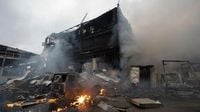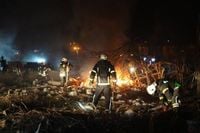In the early hours of November 24, 2025, the city of Kharkiv in northeastern Ukraine became the epicenter of one of the largest Russian drone attacks since the start of the full-scale war, leaving a trail of devastation, heartbreak, and uncertainty for thousands of residents. According to multiple Ukrainian and international media outlets, including Kyiv Independent, The Caspian Post, Euromaidan Press, and Suspilne, the assault killed four people and injured at least seventeen, among them children as young as eleven and twelve. The strikes set three residential buildings ablaze and severely damaged key infrastructure, plunging sections of the city into darkness and chaos.
For Kharkiv, a city already battered by months of escalating attacks, the night was especially harrowing. Russian forces unleashed more than 160 long-range kamikaze drones across Ukraine, with Kharkiv and its surrounding oblast bearing the worst of the consequences. Oleg Syniehubov, the head of Kharkiv Oblast, reported that the victims included women aged 27, 41, and 69, and a 55-year-old man. Fourteen others were wounded, among them an 11-year-old girl and a 12-year-old boy. Kharkiv Mayor Ihor Terekhov told Euromaidan Press that seventeen people sought medical assistance in the aftermath.
The attacks were concentrated in the Shevchenkivskyi and Saltivskyi districts, where fifteen unmanned aerial vehicles (UAVs) struck residential neighborhoods. The Kholodnohirskyi district also suffered, with a security guard killed in one of the blasts. The violence was not limited to statistics; it was deeply personal for victims' families. One particularly wrenching story, reported by Suspilne and confirmed by Mezha, involved a 64-year-old woman named Nataliia. She died while talking to her son, Oleksandr, on the phone as a Shahed drone descended. "She said it was getting lower, then screamed—and then the line went dead," Oleksandr recounted. He rushed to the scene but found no pulse. "There are no options left. The pulse was already gone," he told reporters, his grief palpable.
Another woman, a mother of two, lost her life in her kitchen when a drone struck her building. Her husband and children had escaped moments earlier after hearing the ominous approach of a Shahed drone. Red Cross rescuers later recovered her body from the rubble. "There were children, but when the first Shahed started falling, they ran out. The children are alive, thank God, the husband is alive, but unfortunately, the woman was killed," said Ihor Klymenko, commander of the rapid response unit of the Ukrainian Red Cross Society, speaking to Suspilne.
The physical destruction was immense. According to Syniehubov, Russian strikes damaged seven single-family homes, a multi-story apartment building, power lines, a civilian enterprise, four cars, and an educational facility in Kharkiv city. Mayor Terekhov confirmed that three residential buildings were "completely destroyed" and that the city's power and heating infrastructure suffered severe damage. "The energy sector and our heating network were the most seriously damaged. We're now working to make sure people don't feel the impact," Terekhov said, as quoted by Euromaidan Press. More than 10,000 consumers in Kharkiv Oblast lost electricity, and rolling blackouts were implemented nationwide as emergency crews raced to repair the battered grid.
Ukraine's Air Force responded with determination, intercepting or suppressing 125 of the 162 incoming drones. The drones, including over 80 Shahed-type kamikaze UAVs and Gerbera decoys, were launched from multiple directions—Kursk, Bryansk, Oryol, Millerovo, and Primorsko-Akhtarsk in Russia, as well as Hvardiiske in occupied Crimea. Despite these defensive efforts, the scale and intensity of the assault overwhelmed local resources and left many communities vulnerable.
Kharkiv was not the only region under fire. Russian drones also targeted civilian port infrastructure in Odesa Oblast, damaging equipment and igniting a fire on an unused vessel. Emergency responders quickly extinguished the blaze, and no casualties were reported. In Chernihiv, morning drone strikes damaged a private home and injured two young people, a brother and sister born in 2002 and 2006, according to Ukraine’s National Police. The village of Zhadove in Novhorod-Siverskyi District was also hit, damaging a fire station, a residential house, and an outbuilding, though no casualties were reported there.
The violence extended further. In Kherson city, Russian artillery killed a woman and injured another, while in Novovorontsivka, a drone strike on a government building killed a female administrative worker and wounded one other. In Zaporizhzhia Oblast, a Russian FPV drone hit a minivan in Veselianka, killing the driver, and another attack in Bilenke injured two 24-year-old men. Even rural areas were not spared; in Kyrylivka, Kharkiv Oblast, a woman was injured and more than sixty pigs were killed when a Russian strike hit an agricultural enterprise.
Adding to the misery, extreme weather battered Ukraine’s already strained power grid. In Lviv Oblast, strong winds and heavy rain left forty-five settlements without power, compounding the difficulties faced by emergency crews. Ukrenergo, the national energy operator, stated that repair teams were working around the clock to restore damaged equipment wherever safety conditions permitted.
Throughout the day, from midnight to 11:59 p.m., hourly electricity shutdown schedules and maximum power consumption limits for industrial users and businesses were enforced across all regions. The Ministry of Energy reported that the most critical situation was in Dnipropetrovsk Oblast, where over 60,000 consumers remained without electricity by the morning of November 24.
The timing of the attack was particularly striking. As drones rained down on Kharkiv and other cities, US, Ukrainian, and European officials were meeting in Geneva to discuss new proposals aimed at ending Russia’s full-scale war in Ukraine. The contrast between diplomatic efforts abroad and the violence at home could not have been starker.
Kharkiv’s ordeal is part of a broader pattern. The city and its surrounding oblast have faced increasing Russian attacks throughout 2025, often targeting towns and villages far from the frontline. Just days earlier, on November 18, a missile strike on Berestyn killed a 17-year-old girl and injured nine others. In Kruglyakivka village, two civilians were killed by a drone strike while holding a white flag, with investigations into this alleged war crime ongoing. Critical infrastructure in the Lozova community, Kharkiv region, was damaged after repeated Russian attacks, leaving fifteen settlements without power.
These relentless assaults have left many Ukrainians feeling exposed and exhausted, their resilience tested daily. As Oleksandr, the son of the slain Nataliia, reflected, "We live on the Poltava Road, there too, it seems, is more dangerous than here. There is nothing around—nothing at all." Yet, even amid the destruction, local officials, emergency responders, and ordinary citizens continue to work tirelessly to restore what has been lost and to support each other in the face of unimaginable hardship.
The events of November 24 serve as a grim reminder of the ongoing human and infrastructural toll of the war in Ukraine. As negotiations continue abroad, the people of Kharkiv and other affected regions remain on the front lines, enduring the immediate consequences of a conflict with no clear end in sight.






